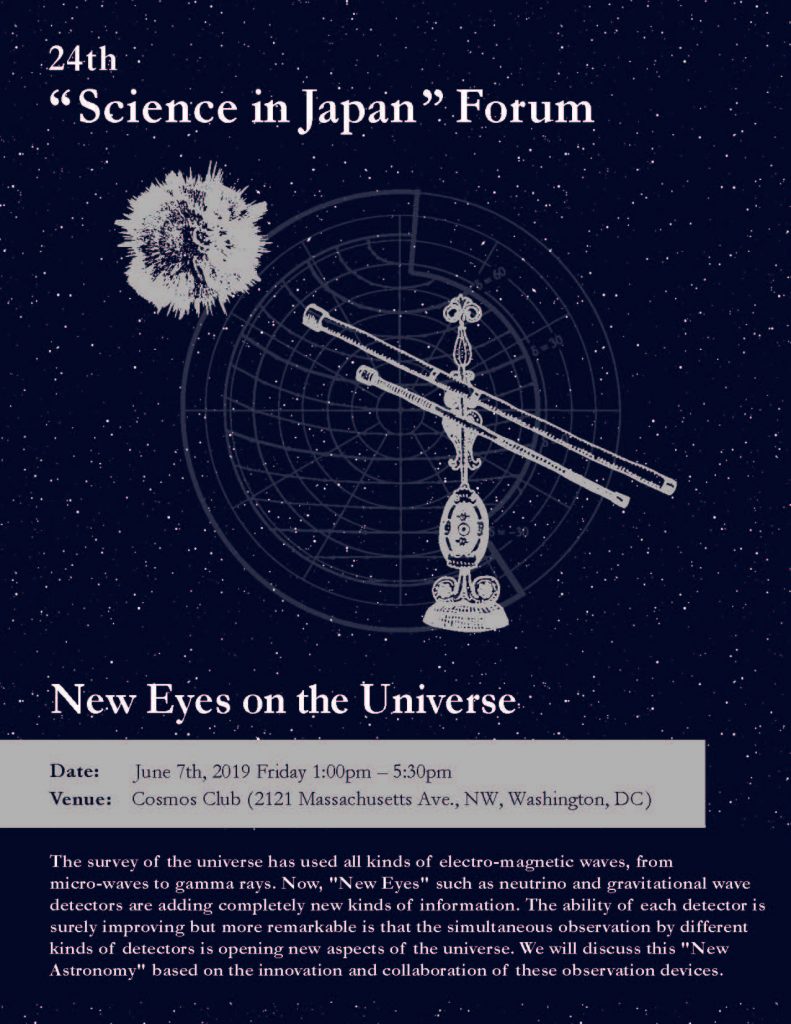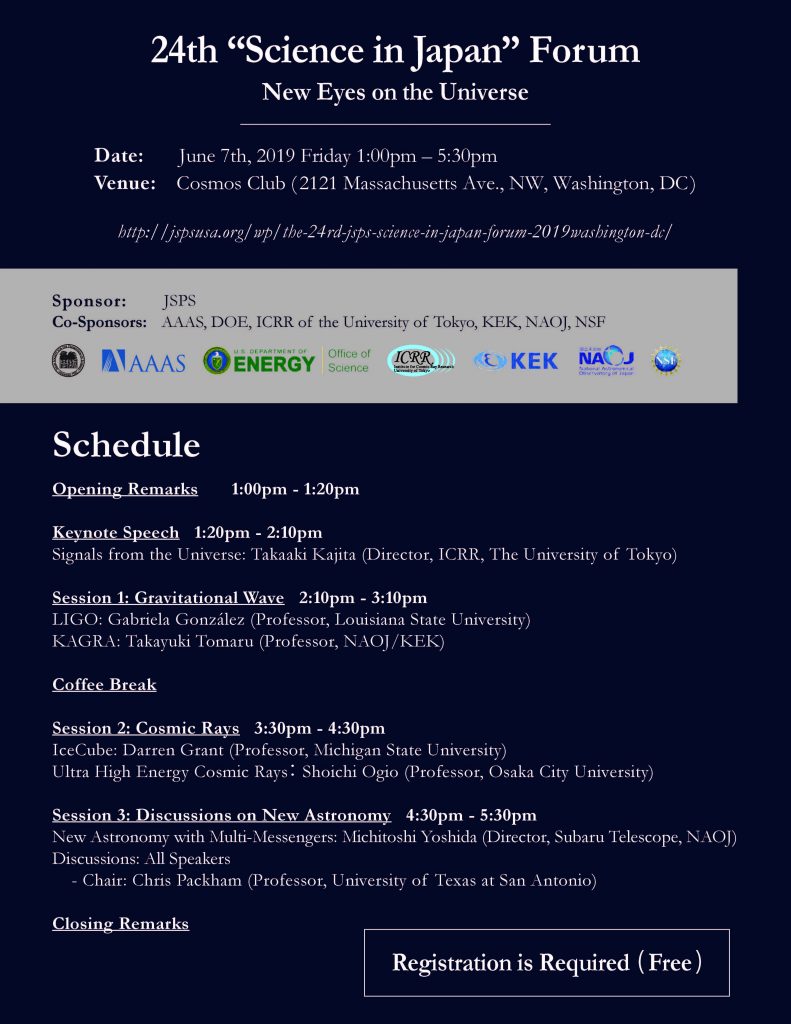Science in Japan Forum 2019
On 7 June, the JSPS Washington Office held its 24th annual “Science in Japan” forum at the Cosmos Club. Located in the Dupont Circle neighborhood, the Cosmos Club is a private social club for distinguished individuals in science, literature and the arts. The theme of the event was “New Eyes on the Universe,” which refers to newfound capabilities to study the universe through high energy cosmic rays including neutrino and gravitational wave detection. When combined with observation by optical and radio telescopes, astronomers and astrophysicists can unlock new breakthroughs about the universe through “Multi-Messenger Astronomy” (MMA). In this sense, electro-magnetic waves, various particles and gravitational waves are referred to as “messengers” that can help to discover fundamental facts about the universe and physics.
Attendees came from a wide range of professions and organizations, including a group from the National Science Foundation (NSF), who attended to collect insights from talks to identify opportunities for collaboration with JSPS. NSF Program Officer for Particle Astrophysics James Whitmore had nominated one of the speakers and noted the fundamental nature of the research to be discussed and the difficulty in envisioning practical applications. A faculty member from Kyoto University with a background in linguistics was present and noted the depth of intellectual collaborations between the U.S and Japan. Individuals who attended on their own behalf included an individual from a consulting group and an adult graduate student who were generally curious about the history of these fields, as well as an intern from a U.S. aerospace company who is pursuing a career in space policy.
Opening Remarks
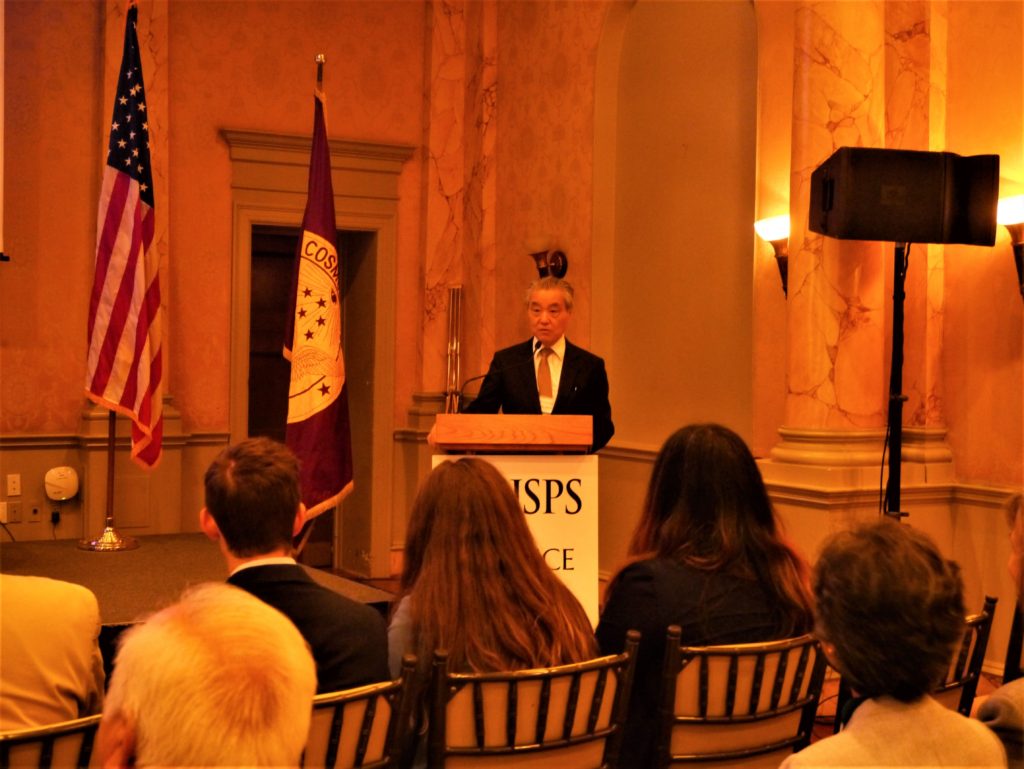
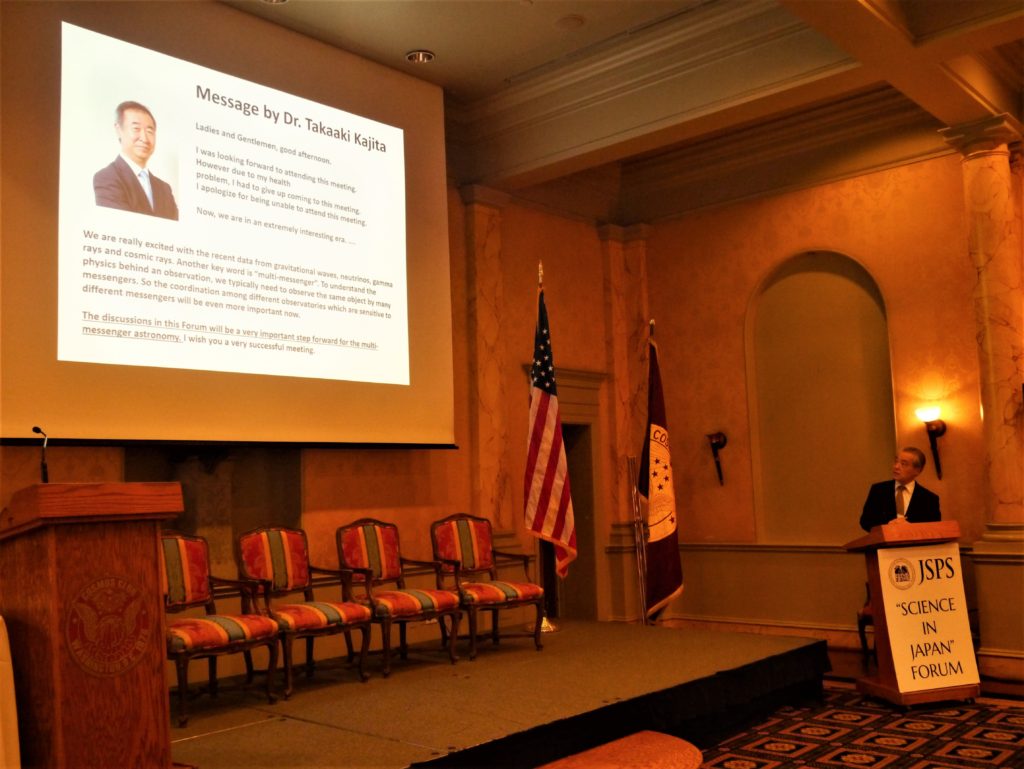
Director of the JSPS Washington Office Dr. Kohji Hirata provided the opening remarks, in which he highlighted the critical role of JSPS in supporting a wide range of natural sciences, humanities and social science research in Japan. While JSPS does not fund research in foreign countries directly, he expressed JSPS’ desire to establish greater collaborations between Japanese and North American researchers. Dr. Hirata unfortunately had to break the news to the audience that keynote speaker and Nobel Prize Winner Dr. Takaaki Kajita would not be attending the event due to unforeseen circumstances. Dr. Kajita received the prize in 2015 for making a breakthrough discovery in “neutrino oscillations,” which proved that the particle indeed had mass, which contrasted hypotheses in the Standard Model of particle physics that assumed they were mass-less. A message from Dr. Kajita was distributed, which discussed importance of multi-messenger astronomy for making observations that go deeper into the nature of the universe and physics. He then emphasized the importance of the ensuing discussion at the seminar for advancing multi-messenger astronomy and facilitating world-wide collaboration.
Mr. Seiichi Shimasaki, Science Counselor of the Embassy of Japan in the United States, spoke next to give an overview of some of the breakthroughs that the invited guests would discuss. He praised the 2015 discovery of gravitational waves by the Laser Interferometer Gravitational-Wave Observatory (LIGO) project in the U.S, which is now forming an international network in collaboration with a similar observatory in Japan known as the Large-scale Cryogenic Gravitational wave Telescope (KAGRA). Mr. Shimasaki also noted an upcoming project by the Japan Aerospace Exploration Agency (JAXA) to launch satellites to measure cosmic rays to help understand the history of the universe. He ended his speech by discussing the prospects of using data analytics and artificial intelligence (AI) as a key tool to analyze massive datasets produced by projects, and how astrophysics is “on the verge of piercing the universe’s greatest mysteries.”
Keynote Speech (replacement for Prof. Kajita): Dr. Richard Green, National Science Foundation (NSF)
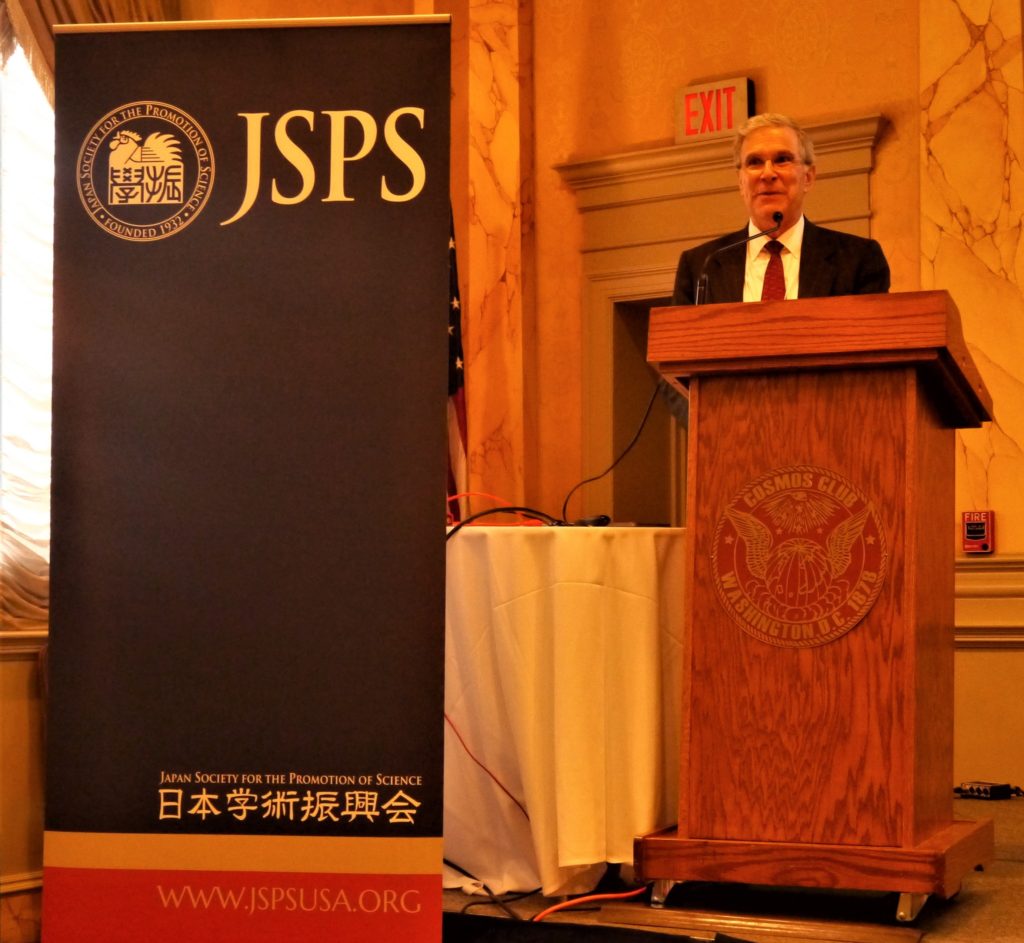
Dr. Richard Green, Division Director of Astronomical Sciences at NSF, began by thanking JSPS for the privilege of attending the event and stressed how it would not have been possible without Dr. Kajita’s vision and work. He emphasized the critical importance of collaboration on MMA, and how the NSF views this field as a major contributor to their overall research objectives.
Dr. Green discussed a number of notable international collaborations and future opportunities. The Atacama Large Millimeter Array (ALMA), a collaboration involving North American, Japanese and European partners, studies warm gases and hot dusts in space which can reveal insights about planetary formation. He briefly discussed international collaboration on the Ice Cube project, where strings of photo multiplier tubes are buried in ice that can detect and measure the energy and direction of neutrinos which can help reveal neutrino sources (such as blazars) and the way they are launched across the universe. He took the opportunity to introduce a number of NSF grants including future collaborations on LIGO research and a wide range of astrophysical investigation grants.
Dr. Green also discussed the history of multi-messenger astrophysics. A century ago, scientists such as Victor Hess, Robert Millikan and Jacob Clay noted that there were ionizing forces impacting earth’s atmosphere. In the 1960s, scientists such as John Bahcall and Raymond Davis began experimenting with methods to detect neutrinos and made fundamental contributions to our understanding of the particle. During an event in 1987 known as “SN 1987a,” several neutrino detectors went off hours before the visible light from a collapsing supernova was observed, with observations confirming that 99% of the energy of a supernova core collapse is radiated away in the form of neutrinos.
He ended his presentation by stating that he believes international collaborations around MMA are primarily driven by the curiosity and intellectual drive of scientists who build new machines, invent new technology and invite investment to answer pressing questions.
1st session, Gravitational Wave, Speaker #1: Prof. Gabriela González, Louisiana State University
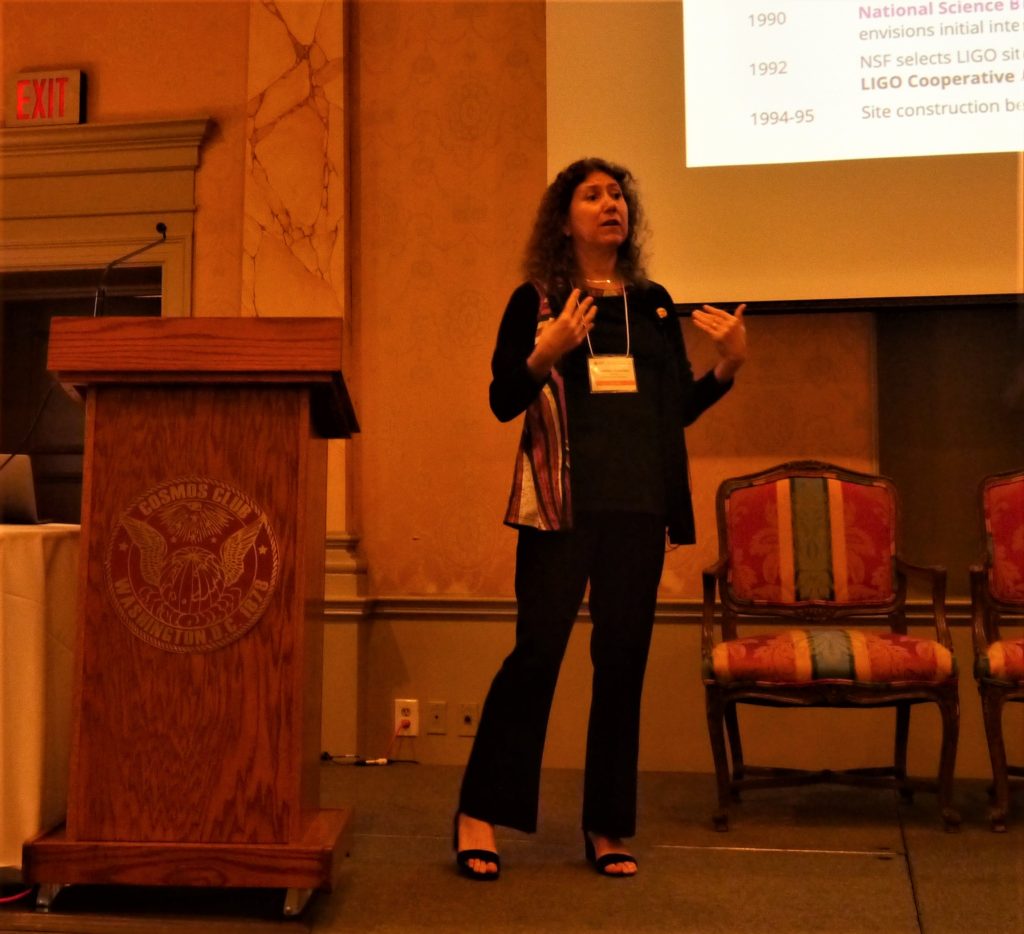
Dr. Gabriela González spoke regarding her work observing gravitational waves as part of the LIGO project, an undertaking which took decades of efforts from thousands of individuals around the world.
She began by presenting Albert Einstein’s theory on the existence of gravitational waves, who hypothesized that two large masses rotating each other produced the ripples of space-time distortion in space-time. To confirm this hypothesis, researchers around the world experimented with interferometers. These devices, which run perpendicular lasers in a vacuum, must reach the kilometer-scale to achieve the necessary sensitivity to detect gravitational waves. This led to the LIGO scientific collaboration, involving two detectors, and the eventual detection of a gravitational wave in 2015 that was attributed to the merging of two black holes.
The Italian detector VIRGO joined the project in 2016, which led to more detections. With more detectors involved, researchers can achieve greater localization of the cosmic event that is producing the gravitational waves to allow astronomers to investigate their source. The Japanese detector KAGRA is expected to join the network soon, while an Indian detector will join in 2026.
One such detection included a signal that lasted 10 seconds rather than a fraction of a second, which indicated that the signal came from a neutron star merger, the first time such an event had been observed using both light and gravitational waves. The wave detected was designated GW170817 and led to the revelation that gravitational waves travel at the speed of light. This led to a paper published involving 3,000 collaborators comparing data to disentangle information on this multi-messenger event. Dr. González was asleep when the signal came through and recalls awakening at 7:30 am to numerous emails discussing the signal and calling her colleagues to see what was going on.
Dr. González played audio clips for the audience where the frequency of these gravitational waves was converted into sound, which she described as the “first two notes of the gravitational wave symphony.” Dr. González ended her presentation by expressing excitement about the prospect of increasing the sensitivity of detectors and possible improvements to the technology to reveal insights about the nuclear physics of these cosmic events.
When asked about the practical applications of research on gravitational waves, Dr. González referred to Einstein’s theory of relativity; if anyone had asked Einstein what his theory was useful for, he would say for understanding the universe. However, without Einstein’s theory of relativity, the world today would not have ubiquitous and highly useful applications such as Global Position Systems (GPS). She feels a similar way about gravitational waves, as it is not currently possible to envision the practical applications of such work that aims to unlock fundamental properties of the universe. The technology used in the gravitational wave facilities is cutting-edge, and includes work by the private sector on vacuum systems, seismic isolation, sensing technology, and reflective coatings for large optics, which will have more general applications.
1st session, Gravitational Wave, Speaker #2: Prof. Takayuki Tomaru, National Astronomical Observatory of Japan / High Energy Accelerator Research Organization (KEK)
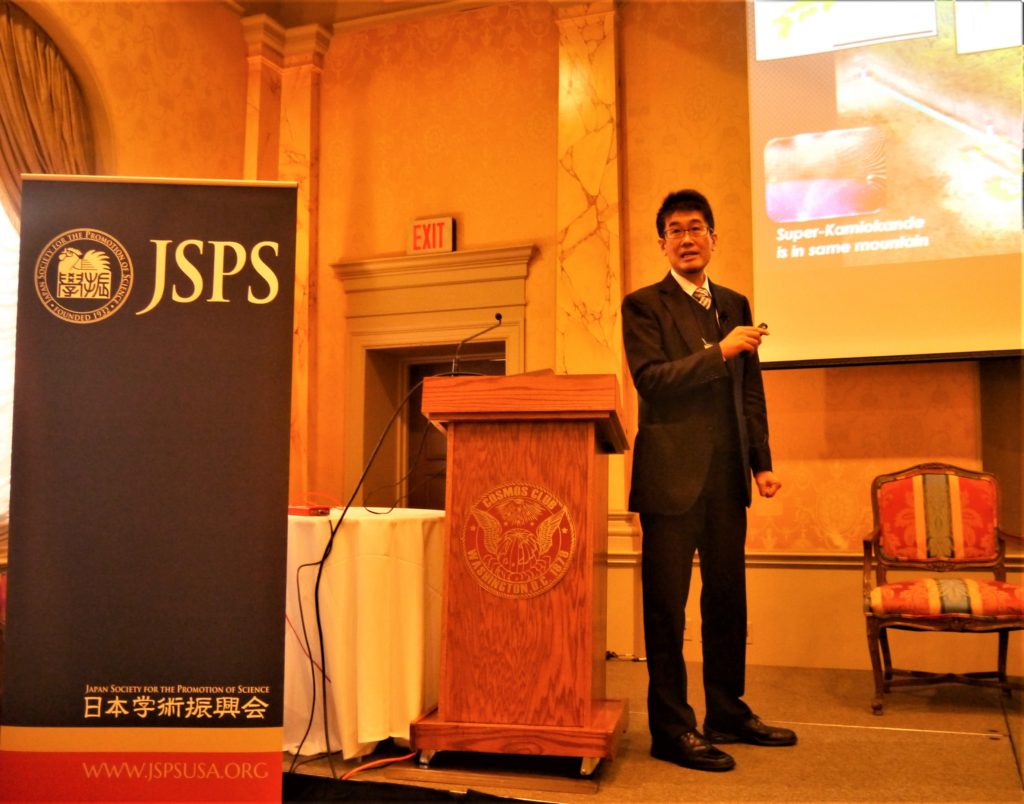
Dr. Takayuki Tomaru of the Gravitational Wave Project Office of the National Observatory of Japan spoke about the KAGRA detector which is under construction in Kamioka, Japan. He began by introducing the problems with gravitational wave detectors that the KAGRA project aims to resolve. Namely, interferometers have good sensitivity in two directions, but have poor angular resolutions which makes localizing the source of the waves difficult. When the VIRGO detector joined the LIGO network, localization was improved considerably, while the addition of KAGRA will bring a tenfold increase in localization improvement, since having multiple detectors located in different geographical locations allows for better triangulation of the source.
Furthermore, the sensitivity of existing interferometers such as LIGO and VIRGO detectors is limited in the low and mid-frequency ranges by seismic noises and thermal noises, respectively. To mitigate these challenges, KAGRA is located underground in a low seismic activity area to limit seismic noise, while an innovative cryogenic mirror system limits thermal (heat) noises.
Dr. Tomaru then discussed a number of problems that the team encountered in the construction of the facility, such as water leaking into tunnels, as well as several instrumentation challenges that the KAGRA team engineered innovative solutions to mitigate, such as the ‘geometrical anti-spring.’ Despite these challenges, the installation of hardware has been completed. Prof. Tomaru concluded his presentation by emphasizing that KAGRA was the “2.5th generation” of detectors and how technological breakthroughs made by his team will be used in future telescopes.
After the seminar, Dr. Tomaru discussed some of the other technical challenges encountered when constructing the $160 million facility. Given the sensitive nature of these measurements, the team has to be very attentive to conditions such as temperature and pressure to ensure the detector can achieve its mission, requiring a number of clever workarounds to unforeseen challenges.
2nd session, Cosmic Rays, Speaker #1: Prof. Darren Grant, Michigan State University
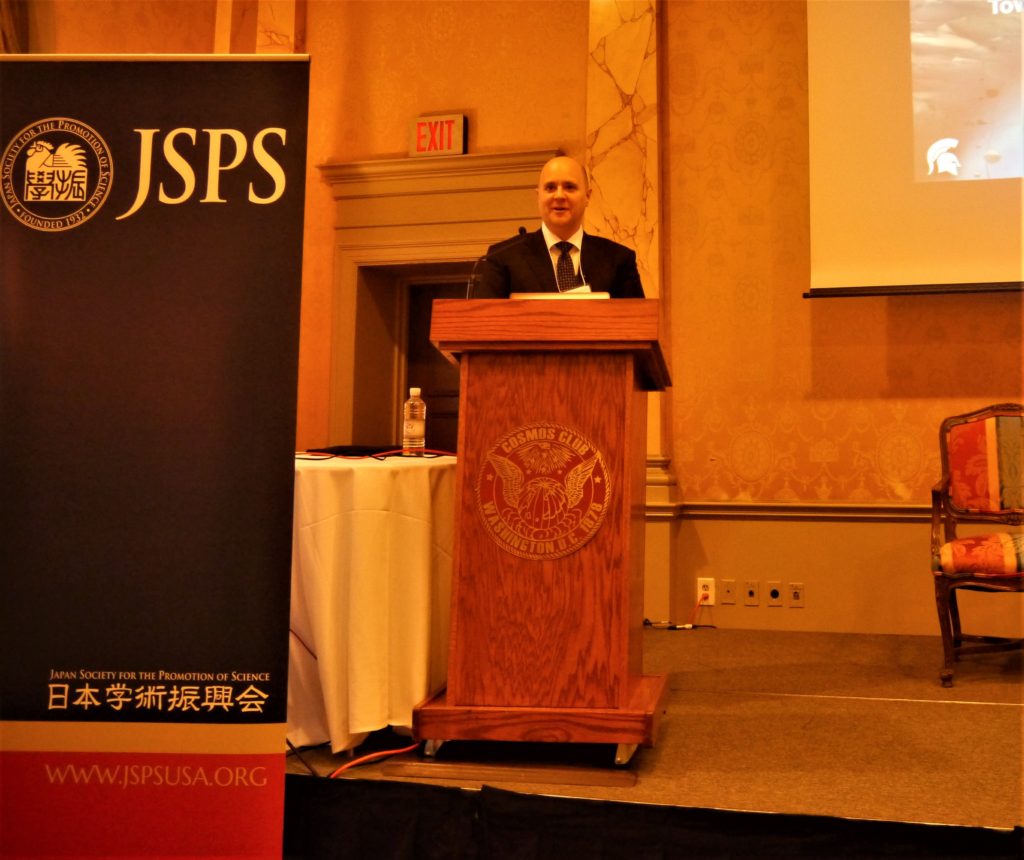
Dr. Darren Grant began his presentation by discussing the nature of the neutrino; he described them as fundamental particles of nature that are the neutral partners of other particles such as electrons. They are the second-most common particles after photons, and rarely interact with matter. He pointed out to the audience that by the time he finished his introductory slide, 3,000 trillion neutrinos had passed through our bodies.
Dr. Grant also reviewed some of the history related to neutrinos, including Kenneth Greisen’s proposed detector to look for neutrinos from the crab nebula, and Fred Reines’ first measurements of neutrinos. In the 1960s, Moisey Markov proposed the first underwater neutrino detector. Such approaches use optical module photodetectors that detect ‘Cherenkov radiation’, or the light produced by particles (such as neutrinos) when they pass through a certain medium. Sites for such detector arrays must be deep and must allow light to penetrate. Notable developments on these efforts include detector arrays deployed in the Pacific Ocean off the coast of Hawaii (DUMAND, 1993) and in Lake Baikal in Russia (1996).
In 1988, Francis Halzen and J.G Learned began their project known as AMANDA to deploy detector arrays buried in 2 kilometers of ice, leading to the first measurements of very high energy neutrinos. The IceCube initiative, the successor to AMANDA, includes an expanded array in Antarctica to enable astronomy using neutrino measurements, by identifying sources such as super massive black holes and gamma ray bursts. The project includes 52 institute worldwide, including NSF and JSPS. IceCube allows the measurement of the highest energy neutrinos ever recorded; about one each month is recorded, with researchers assigning them names such as “Bert” and “Ernie” from the children’s program Sesame Street. Dr. Grant mentioned that the project is also seeking to uncover secrets regarding the nature of dark matter, one of the universe’s greatest mysteries.
In September 2017, Dr. Grant was awoken by an alert of an event of extra-galactic origin detected by IceCube. Once such a detection is made, IceCube personnel notify astronomers to train their telescopes on an area of the sky to search for the source; this led to the observation of a gamma ray emissions from a blazar. The team went back in their data and saw a number of neutrino events from the same source direction in late 2014. Dr. Grant compared the mapping of these neutrino sources to a negative photograph; the whole picture becomes clearer as time goes on and more data is collected.
Dr. Grant ended his presentation with a quote from Mick Jagger, “Anything worth doing is worth overdoing,” and emphasized his ambition for IceCube Generation 2 to achieve 10-20 times as much sensitivity to produce further astronomical insights using neutrinos.
2nd session, Cosmic Rays, Speaker #2: Prof. Shoichi Ogio, Osaka City University
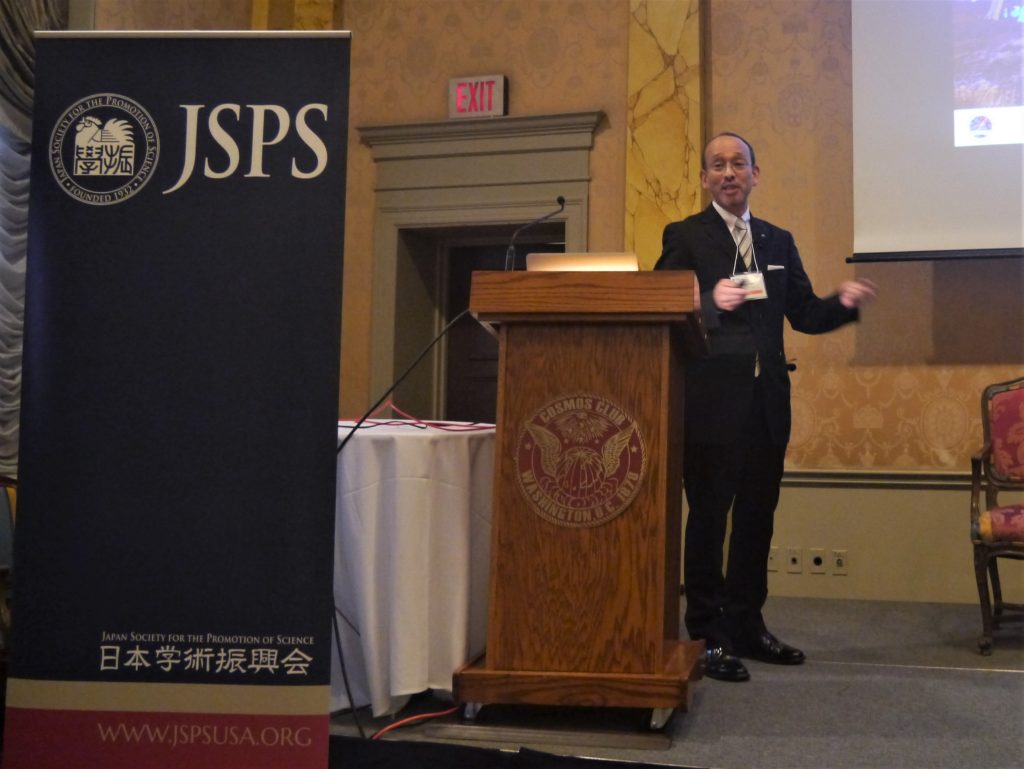
Dr. Shoichi Ogio of Osaka City University’s presentation focused on ongoing experiments in observations of ultra-high energy cosmic rays (UHECRs). Cosmic rays are high energy particles such as high energy protons and atomic nuclei that travel through the universe in non-linear trajectories, and are affected by terrestrial, galactic and intergalactic magnetic fields. These particles can reach extremely high energies for their size; their energy of 50 joules is roughly equivalent to the force from a standard baseball thrown at 60 miles per hour. Their source is unknown, although physicists believe their mechanism of acceleration is fermi acceleration; thus, identifying the source of UHECRs requires identifying astrophysical objects that could accelerate them to these energies.
Source candidates for UHECRs include gamma ray bursts (produced either by a core collapse of a massive star, a neutron star merger, or neutron star-black hole merger) and active galactic nuclei. Very large detector arrays (about 100km2) are necessary to detect these extremely rare events. They can be detected using optical techniques by detecting fluorescent light (a fluorescence detector) produced by the interaction between UHECRs and the atmosphere. The Japanese Tokyo-1 detector recorded the first such fluorescence event. Each detector uses devices called scintillators or surface detectors, which generate photons in response to incident radiation. Examples include Volcano Ranch in New Mexico, where 90 scintillators were deployed over 8km2 between 1959 and 1978, and the Akeno Giant Air Shower Array in Yamanashi Prefecture in Japan, involving 111 scintillators over 100km2.
Dr. Ogio belongs to the Telescope Array project, which constructed an array combining 38 fluorescence detectors and 500 surface detectors between 2003 and 2008. The combination of these two approaches allows for both analysis of the direction the cosmic ray comes from, as well as indicators of the chemical composition of the cosmic ray. He showed the audience a number of pictures and diagrams of the area, and described plans to greatly expand the experiment by adding more detectors and increasing the area covered to 3,000km2.
He ended the presentation by highlighting upcoming projects that could reveal more hints about the source of UHECRs, and emphasizing the importance of international collaborations. These include AugerPrime in Argentina, where instrumentation upgrades are being made to surface detectors to allow event-by-event composition of information, the Probe of Extreme Multi-Messenger Astrophysics (POEMMA) project to observe cosmic ray air showers using satellites in space at the University of Chicago, and the fluorescence detector Array of Single-pixel Telescopes (FAST) which aims to address requirements for a large-area and low-cost detector for measuring properties of UHECRs.
At the reception, Dr. Ogio was asked what the next step in his research would be if the source of UHECRs were to be discovered. He explained that the next step would be to solve how cosmic rays propagate through the universe from their source and reach the earth, which would then allow analysis of the strength and distribution of matter. Given that this is very fundamental science, he was not sure what the implications of these discoveries would be, but it could map the distribution of dark matter and other fundamental physics questions.
3rd session, Discussions on New Astronomy, Speaker #1: Prof. Michitoshi Yoshida, Subaru Telescope, National Astronomical Observatory of Japan
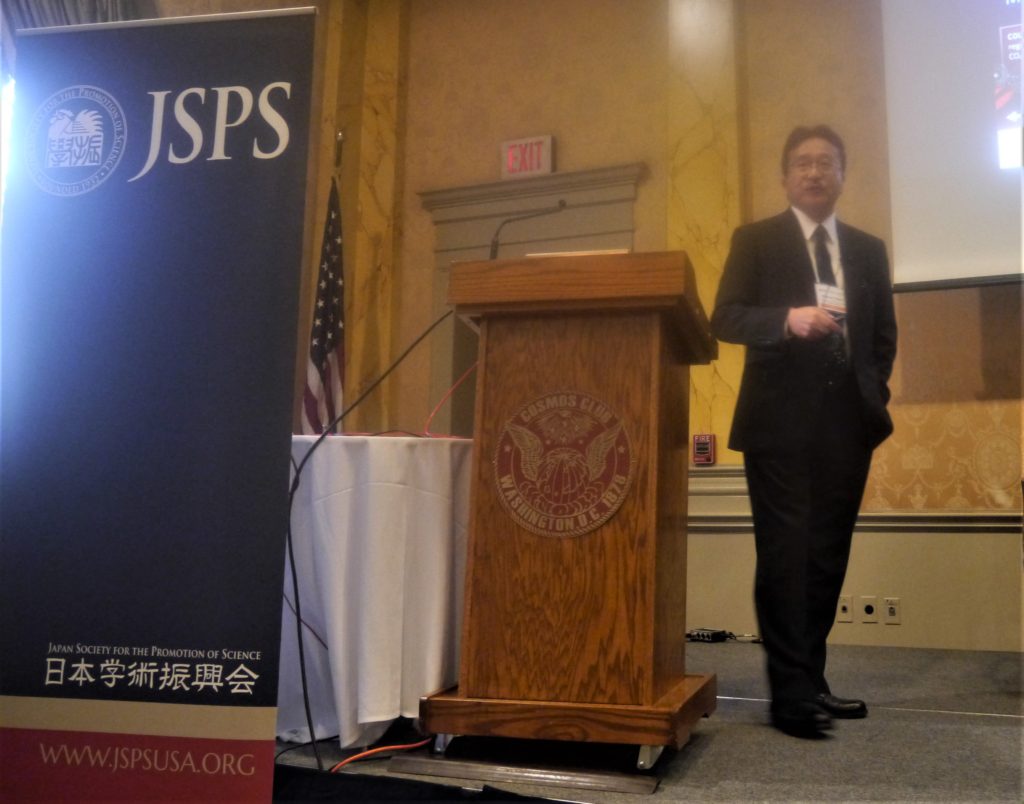
Dr. Michitoshi Yoshida, Director of the Subaru Telescope of the National Astronomical Observatory of Japan, presented on a number of key topics in MMA. He outlined how physicists and astronomers are using various electromagnetic waves to explore different aspects of the universe. For example, radio waves allow us to explore cold gases; infrared light correspond to cool stars and dust; optical techniques allow us to see stars; ultraviolet radiation indicates hot stars and hot plasma; and X-rays correspond to hot gas.
He defined MMA as astronomy leveraging these different wavelengths, along with gravitational waves and particles such as neutrinos and cosmic rays, and mentioned some historical breakthroughs. These include the 1948 detection of cosmic rays associated with solar flares, the 1964 detection of the solar neutrino, and the initiation of neutrino astronomy with the SN 1987A event detected by the Kamiokande detector.
His next topic of discussion was the synthesis of heavy metals such as gold and platinum in the universe, a long-standing mystery for astronomers and physicists. He discussed the hypothesis that if heavy metals were synthesized during neutron star mergers, then the optical emissions from such an event would decay faster than infrared emissions. After the seminar, Dr. Yoshida explained that this hypothesis is based on the opacity of heavy metals; these elements block optical radiation, while infrared radiation passes through, which has been confirmed by data collected from neutron star merger observations using the Subaru Telescope. One such observation, the GW178017 discussed by Dr. González, led to other insights regarding the origin and emission mechanisms of gamma ray bursts, the interactions between relativistic jets and interstellar media, and the structures of neutron stars.
Dr. Yoshida then discussed the localization problems of detectors that had been discussed by other speakers. He showed diagrams of the localizations produced by the LIGO detector network; despite advances, they still include massive samples of stars to sort through to discover the source of the event producing gravitational waves. Dr. Yoshida presented a solution for this challenge: the Japanese Collaboration for GW Electromagnetic Follow up project (J-GEM), which uses narrow and wide-field telescopes to follow up on GW detection more efficiently.
He concluded the presentation by musing about the future possibilities of MMA, such as revealing further insights into cosmic nucleosynthesis (such as heavy metals), uncovering the mechanisms of supernova explosions and the formation of neutron stars, probing inside of stars through the study of gravitational waves, and determining the origin and nature of gamma ray bursts.
3rd session, Discussions on New Astronomy, Panel Discussion
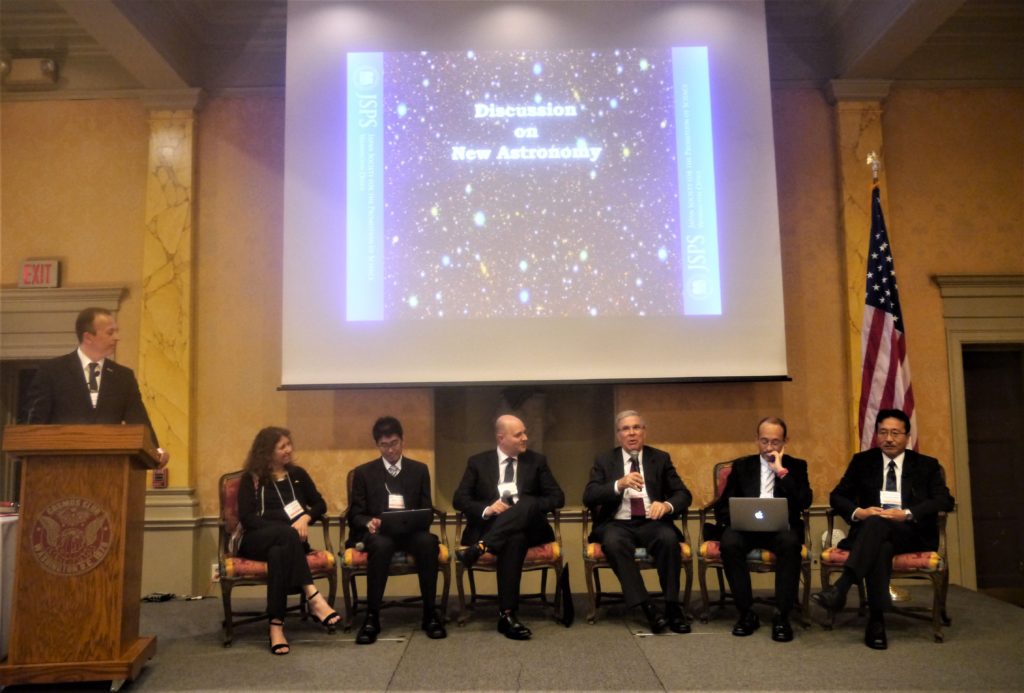
The panel discussion began with Dr. Christopher Packham of University of Texas at San Antonio, the moderator, asking the panelists about various principles and ways forward with MMA. Dr. González considers MMA as a way to “add different senses to better understand the universe,” and Dr. Tomaru considered the possibility of determining the distance of astronomical objects and events through improving the sensitivity of gravitational wave detectors. Dr. Grant noted that the primary way to synergize collaborations on MMA is to continue to develop open policy across researchers and experiments, which Dr. Yoshida agreed with by pointing out that some actors in the space lack an open data policy. Dr. Green provided an example of such a lack of synergy; when the first neutron star merger was detected, “everyone turned their telescopes towards that – that is a waste of resources.” He suggested a way to process alerts so the right telescope can be assigned the right job. Dr. Ogio noted that while he is in the field of charged particles rather than MMA, his field also needs a quicker way to analyze data from each event.
The first audience question built on this topic of open policy and data by asking the panel whether it was risky to rely on spontaneous rather than institutionalized collaborations, and how to deal with actors who are not open to sharing data. Dr. González noted that such spontaneous collaborations have seen significant growth in numerous fields, with Dr. Green agreeing by discussing a “bottom-up movement” in the field to collaborate and more efficiently use resources and facilities.
The moderator then asked the panel about methods to promote further collaboration between the U.S and Japan, as well as how to increase interest among early-career scientists. Dr. Green repeated his belief that “the science leads,” but mechanisms such as regular meetings and post-doc/student exchanges could deepen linkages. Dr. Grant stated his belief that early-career scientists are “incredibly intuitive” and generally are attracted to new and exciting ideas such as those being explored in the MMA field.
The next question asked the panelists to choose what observation facility they considered most important to advance the field. Dr. Yoshida noted the difficulty in picking one but noted the importance of large telescopes such as Subaru in performing spectroscopy on target objects. Dr. González, instead of selecting a facility of facilities, instead emphasized the importance of having networks of facilities with similar sensitivity to triangulate sources.
An audience member then asked the panel if it wouldn’t be better to put these detectors in space. Dr. González agreed that it sounds like a good idea but presented the case that the LISA interferometer that started around the same time as LIGO will only be launched into space in 2034.
The next question concerned possible revelations about dark matter that MMA could unveil. Dr. Grant described how the Ice Cube team uses gamma ray formation as a guide to where they should look for matter signatures in terms of neutrinos, although they have yet to uncover any correlations.
An audience member questioned Dr. Yoshida’s assertion that gold could not be synthesized in the core of a star. Dr. Yoshida then walked the audience through his thinking on the issue. Since nuclear fusion is the main reaction in the core of a star, and heavier elements than iron cannot be synthesized by nuclear fusion, this indicates that additional neutron sources are needed to form heavy elements within a star, which can come from neutron capture. He explained that the neutron capture process inside stars is too infrequent to produce heavier metals than lead.
The moderator then called on the panelists to speculate on what could be some major breakthroughs in the next 20 years. Dr. Yoshida said that he was interested in the simultaneous detection of gravitational waves and neutron signals from a supernova, while Dr. Grant expressed confidence that the cosmic ray mystery would be solved. Dr. Ogio hoped that his team could more precisely determine the structure of the a mysterious ‘hotspot’ source of cosmic rays and expects that we will experience another supernova explosion in our galaxy. Dr. González expressed a general desire for deviations from existing theories and moving on to bigger theories regarding fundamental properties of the universe. Dr. Tomaru stressed the need for a larger frequency range for detectors and the possibility of using satellites to explore the millihertz range. Dr. Green noted the asymmetric understanding of the three messengers, and the need for standard models regarding particles and electromagnetic radiation, although there is no underpinning for gravity as well as larger forces such as dark matter.
Dr. Hirata closed the event by inviting the audience to attend JSPS’s next seminars; next November in Boston and next March in Bethesda. At the following reception, Dr. Hirata introduced the Chief Executive Officer of the American Association for the Advancement of Science (AAAS), Dr. Rush Holt. He spoke about his fifty-year association with Japan and recalled watching the Apollo 11 landing from Kyoto. He went on to praise the collaborations discussed at the seminar and how scientific investigation into these subjects transcends national borders and cultural differences. Dr. González and Dr. Green also gave remarks for a toast.
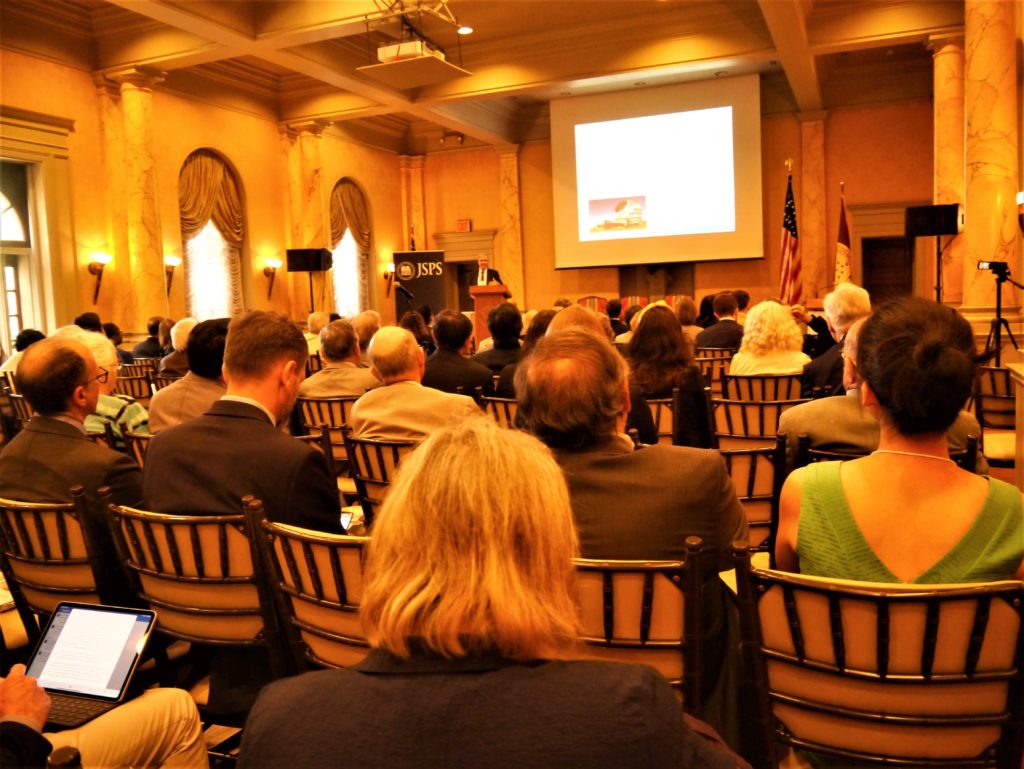
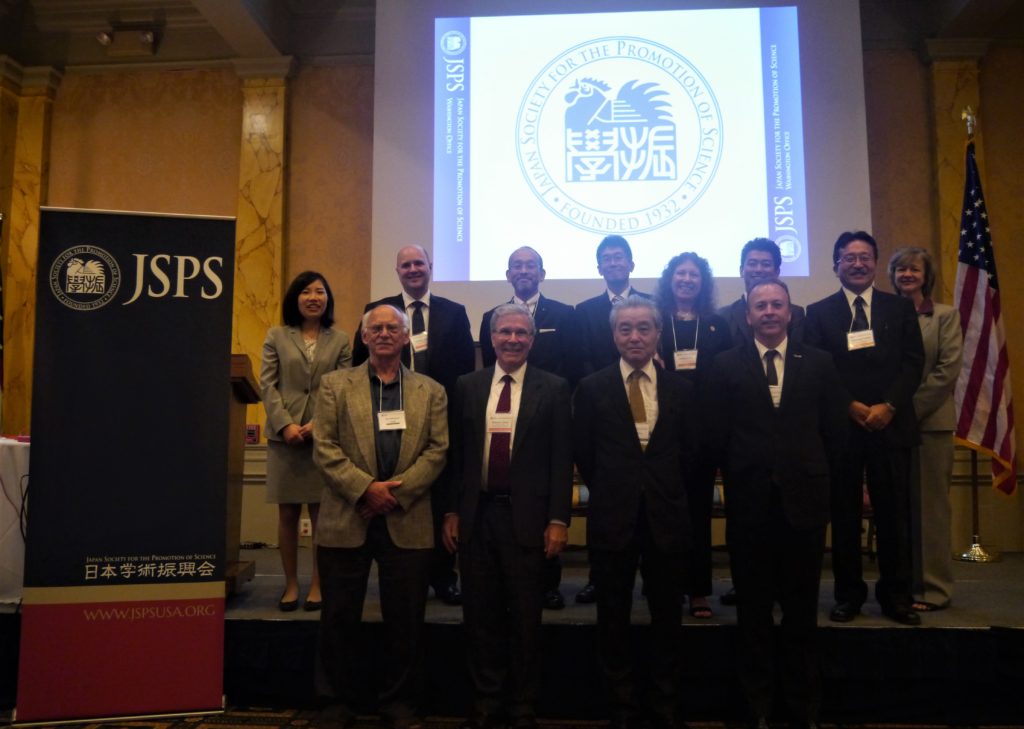
Co-Sponsors :
AAAS (American Association for the Advancement of Science)
DOE (U.S. Department of Energy)
ICRR of University of Tokyo (Institute for Cosmic Ray Research, University of Tokyo)
KEK (High Energy Accelerator Research Organization)
NAOJ (National Astronomical Observatory of Japan)
NSF (National Science Foundation)
